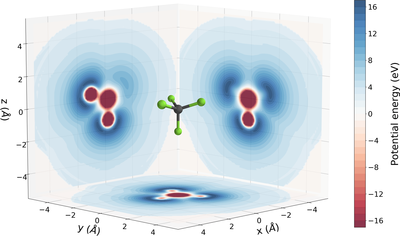Neue Publikation: Attosecond photoionisation time delays reveal the anisotropy of the molecular potential in the recoil frame
An international collaboration coordinated by Prof. Dr. Giuseppe Sansone has demonstrated how the mechanism of photoionization can be used to gain insight in complex molecular potential. The work is published in the journal Nature Communications (H. Ahmadi et al. ““Attosecond photoionisation time delays reveal the anisotropy of the molecular potential in the recoil frame”, https://www.nature.com/articles/s41467-022-28783-x ) and was performed in close collaboration with the Max-Planck Institute for Nuclear Physics in Heidelberg, Germany and the theoretical groups at the Universidad Autonoma in Madrid, Spain, and the University of Trieste, Italy.
In one of his seminal papers in 1905, Albert Einstein interpreted the origin of the photoionization or photoelectric effect. In a simple picture, an atom or a molecule absorbs one quantum of light (usually indicated as photon) from an external field and the absorbed energy is transferred to an electron, which is freed, leaving behind a singly charged ion. In several aspects and for several applications, the effect can be regarded as instantaneous, meaning that there is no significant time delay between the absorption of the photon and the instant when the electron is emitted. However, several experiments conducted in the last years have evidenced that tiny, but measurable delays lying in the attosecond range (1 as=10-18 s) occur between these two processes.
Attosecond pulses.
„Thanks to the advanced laser sources and specially designed spectrometers available in our laboratory, we can generate the shortest bursts of light available to date and lasting only few hundreds of attoseconds. Moreover, we can reconstruct the orientation of simple molecules when they absorb a photon from an external laser pulse. We have used such pulses to investigate the motion of the electrons after the absorption of a photon” explains Sansone.
On its way out from the molecule, the electron experiences a complex landscape characterized by potential peaks and valleys, determined by the spatial distribution of the atoms composing the system. The path followed by the electron during its motion can affect the time it takes to be freed.
Molecular potential.
In the experiment, the time delays accumulated by the electrons emitted from CF4 molecules in different spatial directions were measured using an attosecond pulse train combined with an ultrashort infrared field. „Combining this information with the characterization of the spatial orientation of the molecule, we can understand how the potential landscape and, in particular, potential peaks affect the time delay” explains Sansone.
The work can be extended to more complex molecular systems and to potentials changing on ultrashort timescales. In general, this approach will give the possibility to map complex potential landscapes from within, with unprecedented temporal resolution.

Figure 1. Potential landscape of a CF4 molecule, in which a central carbon atom (in gray) is surrounded by four fluorine atoms (in green) positioned at the vertices of a tetrahedron. The three projections are cuts of the molecular potential, with the blue and red regions indicating points of positive and negative potential energy, respectively.

